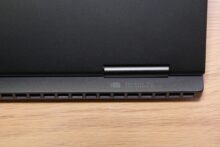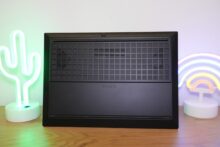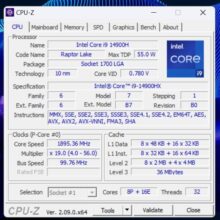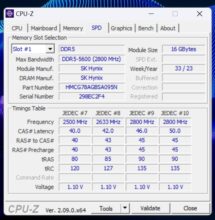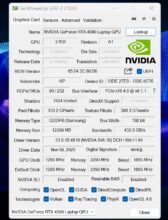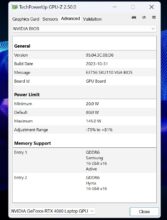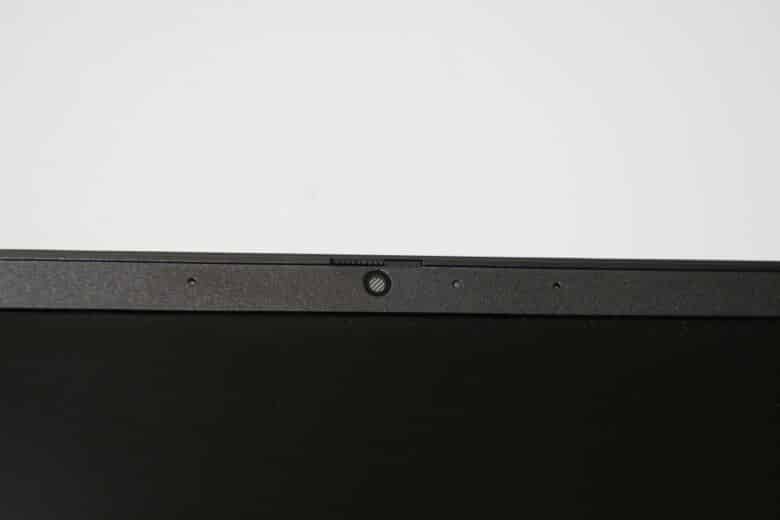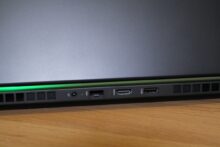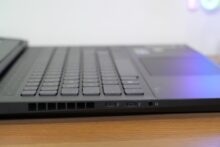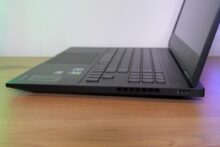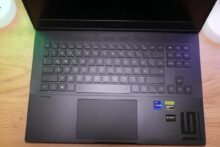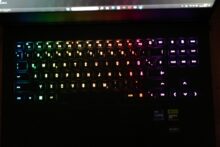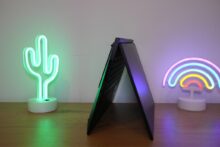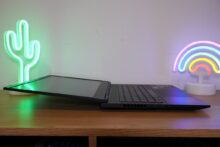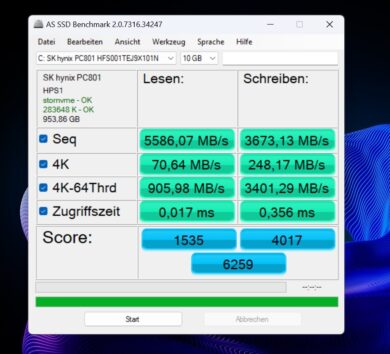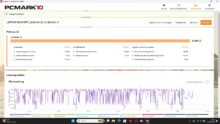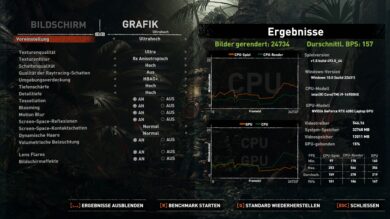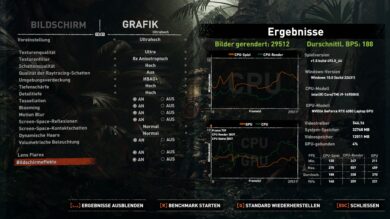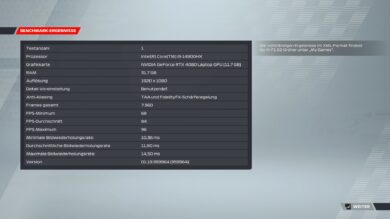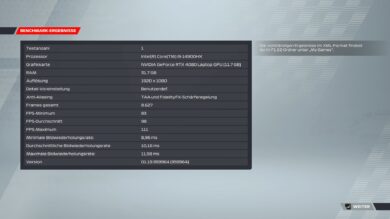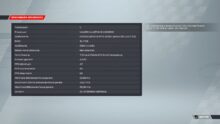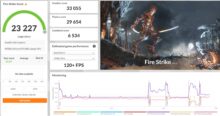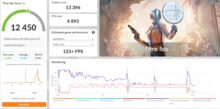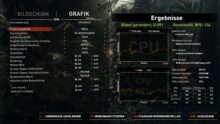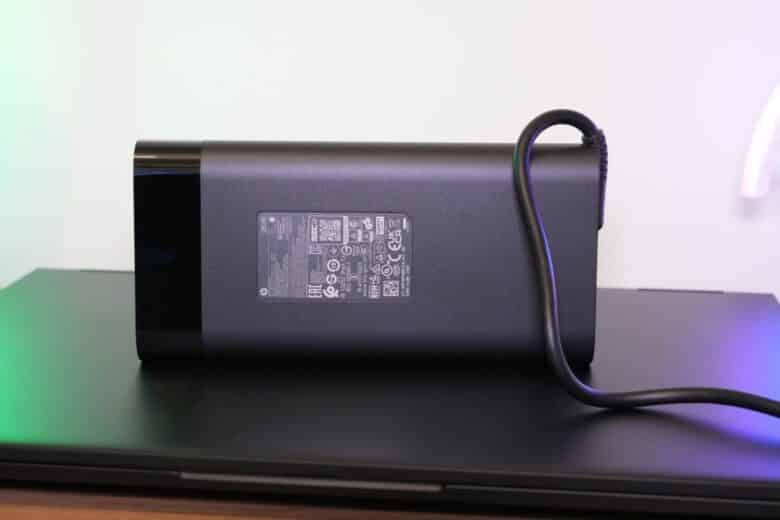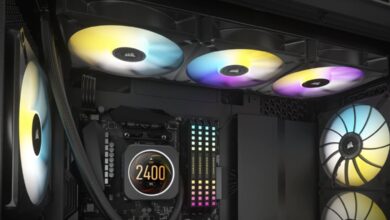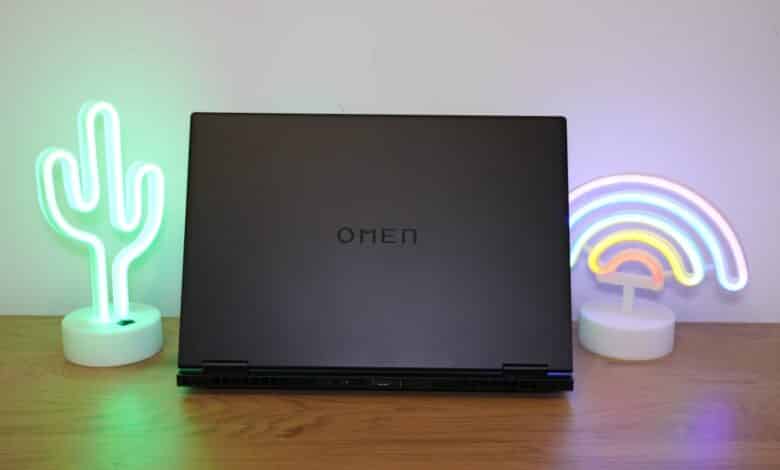
For a fair price, HP puts together a coherent overall package with the new Omen 16 consisting of an appealing 240 Hz display, fast Intel Core i9 14900HX and GeForce RTX 4080. Our HP Omen 16 (2024) review of the model variant “HP Omen 16-wf1078ng” clarifies whether and for whom the purchase is worthwhile.
Technical data
| The product | HP Omen 16-wf1078ng |
| Processor | Intel Core i9-14900HX (24 cores, 2.2 – 5.8 GHz) |
| Graphics performance | Nvidia GeForce RTX 4080 (12GB GDDR6 VRAM); 145 W TDP |
| Display | 16 inch; QHD; 240 Hz |
| Storage space | 1 TB SSD (NVMe PCIe 4) installed |
| Working memory | 32 GB DDR5 RAM (2x 16GB DDR5-5600 SO-DIMM) |
| Keyboard | Mechanical; full size; with RGB lighting |
| Operating system | Windows 11 Home |
| Connectivity | Wi-Fi 6E; Bluetooth 5.3 |
| Dimensions (W x D x H) | 369 mm x 259 mm x 23.5 mm |
| Weight | 2.39 kg (without power supply unit) |
| Price | € 3,276.99 * |



HP Omen 16 (2024) review: Design and build quality
The HP Omen 16 (2024) has the same simple and office-ready design that already characterized its predecessors, such as the Omen 17 (our review). The robust aluminum chassis comes in a dark gray color (Shadow Black) and leaves a very good visual impression.
The most important design difference is that the Omen logo on the lid has been replaced by a corresponding lettering, while the matt surface protects quite well against fingerprints.
It’s a pleasantly discreet design that doesn’t need a lot of bling-bling, while the notebook hardly has any flaws in terms of workmanship. However, as with the Omen 17, the display bounces quite a bit, even with light touches.
With dimensions of 369 mm x 260 mm x 23.5 mm (width x depth x height), the Omen 16 is noticeably larger and bulkier than the Transcend 16 from the same company, which we tested in August 2023.
A gaming behemoth like the XMG Neo 16 (our test), on the other hand, is not only noticeably larger despite the same display size, but also over 100 grams heavier than the Omen 16 at 2.39 kg. Maintenance is carried out via cross-slot screws on the underside of the notebook, which release the RAM (two SO-DIMM) and the M.2 SSD. Both can be exchanged and replaced if required.
Features and connections
The features of the HP Omen 16 (2024) are absolutely impressive. HP combines the Intel Core i9-14900HX with 24 cores and clock speeds of up to 5.8 GHz with 32 GB DDR5-5600 RAM and a 1 TB PCIe 4.0 SSD from SK Hynix.
The NVIDIA GeForce RTX 4080 laptop GPU with 12 GB of VRAM is used as the graphics solution, although it is unfortunately somewhat limited and can only consume a maximum of 145 watts. This is well below NVIDIA’s maximum, which is up to 175 watts.
There is nothing to complain about with the rest of the equipment. It offers modern Wi-Fi 6E, Bluetooth 5.3 and a 1080p webcam with 2.1 megapixel resolution, which offers good image quality and has a hardware shutter.
HP also equips the notebook with two HyperX speakers that support DTS:X Ultra, but unfortunately the sound is not convincing. The sound is okay, but there is an audible lack of detail and bass. The wireless HyperX Cloud II Core gaming headset is included in the scope of delivery.
Connections of the HP Omen 16 (2024)
The HP Omen 16 (2024) is well equipped on the connectivity side. Two Thunderbolt 4 ports with PowerDelivery and DP-Alt mode as well as a combined 3.5 mm jack port await you on the left side.
On the right, however, there is only a single USB-A port (USB 3.2 Gen 1). On the back, you will find Gigabit LAN, HDMI 2.1 and another USB-A 3.2 Gen 1 port in addition to the power connection.
Unfortunately, HP has completely dispensed with an SD card reader. A great pity, because there would have been more than enough space for it on the left. The ports have therefore been taken 1-to-1 from the HP Omen Transcend 16.
The display of the HP Omen 16 (2024)
The display of the HP Omen 16 (2024) marks a small step backwards from the (cheaper) Transcend notebook, as a normal IPS panel is used here instead of a mini-LED display.
However, it does a really good job. It offers a QHD resolution of 2,560 x 1,440 pixels with a rich refresh rate of 240 Hz and a low response time of 3 ms.
The display also scores with a convincing color reproduction, good contrasts and excellent viewing angle stability.
The average brightness is 300 cd/m², which is slightly lower than most other gaming notebooks in this price range. This is particularly noticeable in brighter environments. All in all, a good display, but with the exception of 240 Hz, it doesn’t offer any unique selling points worth mentioning.
Keyboard and touchpad
The chiclet keyboard of the HP Omen 16 (2024) was also taken over from the Transcend, which dispenses with a number pad in favor of slightly wider keys and spacing. Instead, there are two additional keys on the right for the Omen Hub and calculator, although the semi-transparent WASD keys of the Transcend are black here.
The typing feel of the keyboard is absolutely fine, the medium stroke allows precise actuation and the pressure point is clearly defined. The trackpad measures 12.5 cm x 8 cm (width x height) and scores with clear pressure points and a pleasant size.
The keyboard also offers per-key RGB illumination, which can be set in the Omen Hub, but can also be deactivated using the FN key combination.
Practical test of the HP Omen 16 (2024)
In practice, the HP Omen 16 (2024) reveals its first weaknesses and these are sometimes quite serious. This starts with the high noise level of the gaming notebook, even though laptops in this segment are not known for being quiet anyway.
We can choose between three profiles in the Omen Hub: Eco (quiet, but slower), Balanced and Performance.
Even in the balanced mode, which is activated by default, the Omen 16 is quite loud under load with up to 51 dB(A). In performance mode, which teases out a few more FPS in games, it even gets unpleasantly loud at 61 dB(A).
At the same time, the chassis also heats up noticeably under full load. The upper area of the keyboard in particular gets uncomfortably warm when gaming because the fans at the back blow the hot air onto the chassis.
Apart from that, the HP Omen 16 (2024) cuts a very good figure in practice and scores with its excellent performance. The HP Omen Hub also offers practical functions and enables hardware monitoring, adjustment of the RGB lighting and even undervolting of the CPU in a clear layout with extensive explanations for beginners.
Benchmark: Productivity, system, SSD and gaming
How does the HP Omen 16 (2024) with Core i9-14900HX perform in practice? As always, I took a close look at this using various benchmarks and games. All tests were carried out in gaming mode, which provides the maximum possible performance.
I measure the productivity and system performance with PCMark 10 and Cinebench R23. PCMark 10 simulates different workflows when running the benchmark, including word processing, surfing the Internet and spreadsheets. Cinebench, on the other hand, measures the speed of the CPU cores individually and in multi-core mode.
Geekbench 6, which measures the performance of the CPU in single and multi-core mode, as well as the power of the GPU, is now also new to our benchmark test track. In addition, Cinebench 2024 is now also available, which offers better comparison options with a new engine and a more uniform benchmark scene since September 2023.
In addition to the synthetic benchmark 3DMark, various games such as F1 22 including ray tracing, Final Fantasy XV and many more are used for the gaming tests. The SSD speed is measured by AS-SSD.
SSD benchmark: AS-SSD
The SSD used is an SK Hynix PC801 with a capacity of 1 TB and a PCIe 4×4 connection, which scores with very good speeds and low latencies. 5.562.76 MB/s reading and 3,517.86 MB/ writing are absolutely impressive. HP already used the SSD in the Omen 17 (2023).
Fortunately, the PC801 can also maintain this performance with significantly larger files: In the 10 GB test, only minimal drops in performance were measurable.
| Read | Writing | |
| Sequential | 5.562.76 MB/s | 3.517.86 MB/s |
| 4K | 67.96 MB/s | 247.01 MB/s |
| 4K-64Thrd | 865.74 MB/s | 3.623.80 MB/s |
| Access time | 0.017 ms | 0.017 ms |
Cinebench, Geekbench and PCMark
In the Cinebench R23 benchmark, the Core i9 falls well short of expectations, at least in the multi-core test. The results here are more on a par with its predecessor, the Core i9-13900HX.
However, I can’t explain why this is the case. It can’t be due to the power limits or other settings.
The Medion Erazer Beast X40 (our test) has shown what is possible here. Over 29,000 points are theoretically possible in the multi-core test, sometimes even over 30,000. However, the HP Omen 16 only achieves a meagre 18,895 points and is thus on a par with the 13900HX from the Transcend 16.
Only in terms of single-core performance does the current gaming notebook achieve the values that can be expected from the CPU. The situation is different in Cinebench 2024, even though we currently lack comparative values from the gaming notebook sector.
1.038 points in the multi-core test and 128 points in the single-core test are attested by the benchmark for the notebook, which is noticeably more than in the Core Ultra 7 155H or AMD Ryzen 9 7940HS.
However, things look different again in the holistic PCMark test, in which the HP Omen 16 (2024) beats the Medion Erazer Beast X40 both in the overall result and in the sub-areas. With the exception of Digital Content Creation, where the Beast is clearly ahead thanks to the RTX 4090. 8.in any case, 479 overall points is a very good result.
| Benchmark | Benchmark result |
| Cinebench R23 Multi Core | 18.845 points |
| Cinebench R23 Single Core | 2.194 pts. |
| Cinebench 2024 Multi Core | 1.038 pts. |
| Cinebench 2024 Single Core | 128 pts. |
| Cinebench 2024 GPU | 15.154 pts. |
| PCMark 10 total score | 8.479 pts. |
| PCMark 10 Essentials | 11.554 pts. |
| PCMark 10 Productivity | 10.834 pts. |
| PCMark 10 Digital Content Creation | 13.213 pts. |
| Geekbench 6 Multi Core | 16.597 pts. |
| Geekbench 6 Single Core | 3.017 pts. |
| Geekbench 6 GPU | 153.892 pts. |
Graphics and gaming performance
Thanks to the RTX 4080, the HP Omen 16 (2024) offers convincing gaming and graphics performance for QHD resolutions with maximum graphics details. It should be noted that the “Performance” mode enables significantly better performance:
Up to 20 percent higher frame rates are possible, depending on the game in question. If you accept the unbearably loud fans, of course.
In general, however, the gaming performance suffers from the limited graphics unit. With a TGP of 130 watts, the HP Omen 16 cannot draw on the full potential. The performance is noticeably above that of the Omen Transcend 16 with RTX 4070 and also 130 watts, but at least as clearly below what the RX 4080 is capable of with a full 175 watts.
Many other gaming notebooks with this graphics unit achieve significantly better performance and sometimes even at lower prices. Which is a shame. I can only assume that HP was aware of how hot and loud the notebook already gets at 130 watts and didn’t want to increase the power limits any further.
| Benchmark (Balanced mode) | Result |
| Fire Strike Total | 23.227 points |
| Time Spy Total | 12.450 pts. |
| Port Royal Total | 8.735 points |
| Speed Way Total | 3.618 pts. |
| Solar Bay Total | 58.286 pts. |
| F1 22 (Ultra Preset) – 1080p | 84 fps (average) |
| F1 22 (Ultra Preset) – QHD | 66 fps (average) |
| Final Fantasy XV (High Quality) – 1080p | 12.563 pts. |
| Final Fantasy XV (High Quality) – QHD | 9.318 pts. |
| Shadow of the Tomb Raider (Ultra) – 1080p | 157 fps |
| Shadow of the Tomb Raider (Ultra) – QHD | 136 fps |
Battery life
The HP Omen 16 (2024) is equipped with an 83 Wh battery, which is powered by a comparatively compact 280 watt power supply unit. The charging time from 0 to 100 percent is around 1.5 hours, whereby the first 50 percent is quickly charged in just 30 minutes.
However, the runtimes of 2 hours 51 minutes in the PCMark Office test and 1 hour 19 minutes in the gaming benchmark are somewhat meagre.
HP Omen 16 (2024) test: Conclusion
The HP Omen 16 (2024) is a good gaming notebook. No question about it. The workmanship is good, the design is pleasantly simple and the features and modern connections are also pleasing. On the other hand, there are also a lot of things that seem strange or aren’t quite as appealing.
The GeForce RTX 4080 is rather weak compared to the competition. This in turn affects the gaming performance. In addition, the fans are sometimes unbearably loud, especially in performance mode.
All in all, this results in a solid overall package, but it is too expensive considering the performance and quality. The competition offers more for the same or even less money.
HP Omen 16 (2024)
Design & workmanship
Display
Features
Performance
Battery
Value for money
83/100
Simple gaming notebook with convincing features that is well equipped for QHD, but cannot fully exploit its potential and gets very warm and loud under load.




